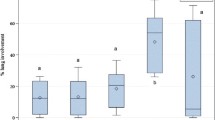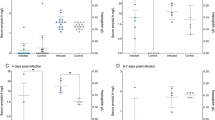Abstract
Mannheimia haemolytica is the main bacterial pathogen isolated in bovine respiratory disease (BRD), a common disease affecting calves before weaning. Previous research has shown that experimental infection with bovine herpesvirus 1, a respiratory virus, decreases plasma zinc (Zn) levels. However, changes in plasma Zn concentrations in calves experimentally infected with M. haemolytica have not been studied thus far. The objective of this study was to evaluate the effect of experimental infection with M. haemolytica on plasma Zn concentration in calves. Total leukocyte count and bovine respiratory disease (BRD) clinical score were also evaluated. We conducted a 6-day trial in 14 male Holstein calves randomly assigned to one of two groups, experimental (EG, n = 8) and control (CG, n = 6). Animals in EG were intrabronchially inoculated with M. haemolytica (6.5 × 106 CFU/mL) on day 0 of the trial. Plasma Zn levels were affected by time, treatment, and time by treatment interaction, being lower in EG compared with CG on days 1, 2, and 3. Differences in total leukocyte count were significant on day 1, observing a tendency on day 3. BRD clinical score differed between groups, being higher in EG throughout the trial. We conclude that experimental M. haemolytica infection reduced plasma Zn concentration in clinically ill calves, suggesting that the clinical condition of animals (healthy/ill) should be considered to better interpret plasma Zn values.


Similar content being viewed by others
References
Rosa DE, Fazzio LE, Picco SJ, Furnus CC, Mattioli GA (2008) Metabolismo y deficiencia de zinc en bovinos. Analecta Vet 30(2):34–44
Bonaventura P, Benedetti G, Albarède F, Miossec P (2015) Zinc and its role in immunity and inflammation. Autoimmun Rev 14(4):277–285
Hujanen ES, Seppä ST, Virtanen K (1995) Polymorphonuclear leukocyte chemotaxis induced by zinc. Copper and nickel in vitro. Biochim Biophys Acta 1245(2):145–152
King LE, Frentzel JW, Mann JJ, Fraker PJ (2005) Chronic zinc deficiency in mice disrupted T cell lymphopoiesis and erythropoiesis while B cell lymphopoiesis and myelopoiesis were maintained. J Am Coll Nutr 24(6):494–502
Prasad AS (2009) Zinc: role in immunity. Oxidative stress and chronic inflammation. Curr Opin Clin Nutr Metab Care 12(6):646–652
Wang RL, Liang JG, Lu L, Zhang LY, Li SF, Luo XG (2013) Effect of zinc source on performance, zinc status, immune response, and rumen fermentation of lactating cows. Biol Trace Elem Res 152(1):16–24
Ibs KH, Rink L (2003) Zinc-altered immune function. J Nutr 133(5):1452–1456
Bogden JD, Oleske JM, Lavenhar MA, Munves EM, Kemp FW, Bruening KS, Holding KJ, Denny TN, Guarino MA, Holland BK (1990) Effects of one year of supplementation with zinc and other micronutrients on cellular immunity in the elderly. J Am Coll Nutr 9(3):214–225
Nunnery GA, Vasconcelos JT, Parsons CH, Salyer GB, Defoor PJ, Valdez FR, Galyean ML (2007) Effects of source of supplemental zinc on performance and humoral immunity in beef heifers. J Anim Sci 85(9):2304–2313
Overbeck S, Rink L, Haase H (2008) Modulating the immune response by oral zinc supplementation: a single approach for multiple diseases. Arch Immunol Ther Exp 56(1):15–30
Kincaid RL (1999) Assessment of trace mineral status of ruminants: a review. Proc Am Soc Anim Sci 77(1):1–10
Lichten LA, Cousins RJ (2009) Mammalian zinc transporters: nutritional and physiologic regulation. Annu Rev Nutr 29:153–176
Aydemir TB, Chang SM, Guthrie GJ, Maki AB, Ryu MS, Karabiyik A et al (2012) Zinc transporter ZIP14 functions in hepatic zinc, Iron and glucose homeostasis during the innate immune response (endotoxemia). PLoS One 7(10):e48679
Aburto-Luna V, Treviño S, Santos-López G, Moroni-González D, Calva-Cruz O, Aguilar-Alonso P, León-Chávez BA, Brambila E (2017) Hepatic mobilization of zinc after an experimental surgery and its relationship with inflammatory cytokines release and expression of metallothionein and Zip14 transporter. Inflamm Res 66(2):167–175
Murray CF, Fick LJ, Pajor EA, Barkema HW, Jelinski MD, Windeyer MC (2016) Calf management practices and associations with herd-level morbidity and mortality on beef cow-calf operations. Animal 10(3):468–477
Duff GC, Galyean ML (2007) Board-invited review: recent advances in management of highly stressed. Newly received feedlot cattle. J Anim Sci 85(3):823–840
Fazzio LE, Landoni MF (2010) Comparación de la eficacia de oxitetraciclina y tilmicosina en el tratamiento metafiláctico de la enfermedad respiratoria bovina en animales de feedlot. Analecta Vet 30(2):35–40
Rice JA, Carrasco-Medina L, Hodgins DC, Shewen PE (2007) Mannheimia haemolytica and bovine respiratory disease. Anim Health Res Rev 8(2):117–128
Verhoeff J, Van der Ban M, van Nieuwstadt AP (1984) Bovine respiratory syncytial virus infections in young dairy cattle: clinical and haematological findings. Vet Rec 114(1):9–12
Orr CL, Hutcheson DP, Grainger RB, Cummins JM, Mock RE (1990) Serum copper, zinc, calcium and phosphorus concentrations of calves stressed by bovine respiratory disease and infectious Bovine Rhinotracheitis. J Anim Sci 68:2893–2900
Soltesova H, Nagyova V, Tothova C, Nagy O (2015) Haematological and blood biochemical alterations associated with respiratory disease in calves. Acta Vet Brno 84:249–256
Piper HG, Higgins G (1967) Estimation of trace metals in biological material by atomic absorption spectrophotometry. Proc Assoc Clin Biochem 7:190–195
Ióvine E, Selva AA (1985) El laboratorio en la clínica: metodología analítica, fisiopatología e interpretación semiológica. 3ra edición. Buenos Aires. Argentina
Love W, Lehenbauer T, Van Eenennaam A, Drake C, Kass P, Farver T, Aly S (2016) Sensitivity and specificity of on-farm scoring systems and nasal culture to detect bovine respiratory disease complex in pre weaned dairy calves. J Vet Diagn Investig 28(2):119–128
Fajt VR, Apley MD, Roth JA, Frank DE, Brogden KA, Skogerboe TL, Shostrom VK, Chin YL (2003) The effects of danofloxacin and tilmicosin on neutrophil function and lung consolidation in beef heifer calves with induced Pasteurella (Mannheimia) haemolytica pneumonia. J Vet Pharmacol Ther 26(3):173–179
Liuzzi JP, Lichten LA, Rivera S, Blanchard RK, Aydemir TB, Knutson MD, Ganz T, Cousins RJ (2005) Interleukin-6 regulates the zinc transporter Zip14 in liver and contributes to the hypozincemia of the acute-phase response. Proc Natl Acad Sci U S A 102(19):6843–6848
Besecker BY, Exline MC, Hollyfield J, Phillips G, Disilvestro RA, Wewers MD, Knoell DL (2011) A comparison of zinc metabolism, inflammation, and disease severity in critically ill infected and noninfected adults early after intensive care unit admission. Am J Clin Nutr 93(6):1356–1364
Corbin BD, Seeley EH, Raab A, Feldmann J, Miller MR, Torres VJ, Anderson KL, Dattilo BM, Dunman PM, Gerads R, Caprioli RM, Nacken W, Chazin WJ, Skaar EP (2008) Metal chelation and inhibition of bacterial growth in tissue abscesses. Science 319(5865):962–965
Gammoh NZ, Rink L (2017) Zinc in infection and inflammation. Nutrients 9(6):E624
Sakaguchi S, Iizuka Y, Furusawa S, Ishikawa M, Satoh S, Takayanagi M (2002) Role of Zn2+ in oxidative stress caused by endotoxin challenge. Eur J Pharmacol 451(3):309–316
Alker W, Haase H (2018) Zinc and sepsis. Nutrients 10(8):E976
Middleton JR, Luby CD, Viera L, Tyler JW, Casteel S (2004) Short communication: influence of Staphylococcus aureus intramammary infection on serum copper, zinc and iron concentrations. J Dairy Sci 87(4):976–979
Enjalbert F, Lebreton P, Salat O (2006) Effects of copper, zinc and selenium status on performance and health in commercial dairy and beef herds: retrospective study. J Anim Physiol Anim Nutr (Berl) 90(11–12):459–466
Suwa T, Hogg JC, English D, Van Eeden SF (2000) Interleukin-6 induces demargination of intravascular neutrophils and shortens their transit in marrow. Am J Physiol Heart Circ Physiol 279(6):H2954–H2960
Underwood EJ, Suttle NF (1999) The mineral nutrition of livestock. CABI Publishing, London
Acknowledgments
Thanks are due to A. Di Maggio for manuscript correction and edition.
Funding
This work was supported by Grant 11/V257 from UNLP.
Author information
Authors and Affiliations
Contributions
EMG, JMA and LEF designed the study. RML, NS and GA assisted with data collection. GAM and EMG analyzed the data. LEF and JMA coordinated the experiments and revised the manuscript.
Corresponding author
Ethics declarations
Conflict of Interest
The authors declare no conflict of interests.
Ethical approval
All the experimental procedures performed in the current trial were approved by the Committee for the Care and Use of Laboratory Animals (CICUAL, for its Spanish acronym), School of Veterinary Sciences, La Plata National University, Argentina, under Protocol N° 55-2-18P.
Additional information
Publisher’s Note
Springer Nature remains neutral with regard to jurisdictional claims in published maps and institutional affiliations.
Rights and permissions
About this article
Cite this article
Galarza, E.M., Lizarraga, R.M., Streitenberger, N. et al. Assessment of Plasma Zinc and Total Leukocyte Count in Calves Experimentally Infected with Mannheimia haemolytica. Biol Trace Elem Res 199, 120–125 (2021). https://doi.org/10.1007/s12011-020-02145-4
Received:
Accepted:
Published:
Issue Date:
DOI: https://doi.org/10.1007/s12011-020-02145-4




